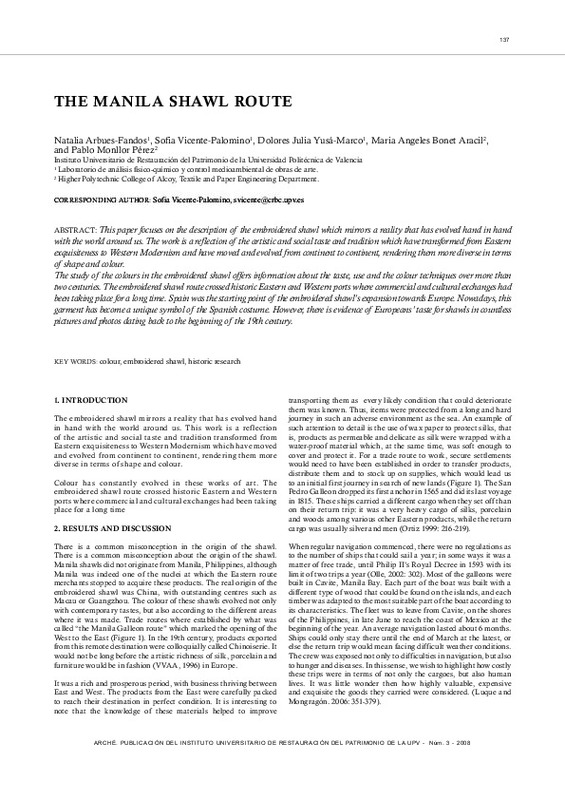JavaScript is disabled for your browser. Some features of this site may not work without it.
Buscar en RiuNet
Listar
Mi cuenta
Estadísticas
Ayuda RiuNet
Admin. UPV
The Manila shawl route
Mostrar el registro sencillo del ítem
Ficheros en el ítem
| dc.contributor.author | Arbues Fandos, Natalia Concepción
|
es_ES |
| dc.contributor.author | Vicente Palomino, Sofía
|
es_ES |
| dc.contributor.author | Yusa Marco, Dolores Julia
|
es_ES |
| dc.contributor.author | Bonet Aracil, María Angeles
|
es_ES |
| dc.contributor.author | Monllor Pérez, Pablo
|
es_ES |
| dc.date.accessioned | 2013-07-29T06:44:31Z | |
| dc.date.available | 2013-07-29T06:44:31Z | |
| dc.date.issued | 2008 | |
| dc.identifier.issn | 1887-3960 | |
| dc.identifier.uri | http://hdl.handle.net/10251/31505 | |
| dc.description.abstract | This paper focuses on the description of the embroidered shawl which mirrors a reality that has evolved hand in hand with the world around us. The work is a reflection of the artistic and social taste and tradition which have transformed from Eastern exquisiteness to Western Modernism and have moved and evolved from continent to continent, rendering them more diverse in terms of shape and colour. The study of the colours in the embroidered shawl offers information about the taste, use and the colour techniques over more than two centuries. The embroidered shawl route crossed historic Eastern and Western ports where commercial and cultural exchanges had been taking place for a long time. Spain was the starting point of the embroidered shawl¿s expansion towards Europe. Nowadays, this garment has become a unique symbol of the Spanish costume. However, there is evidence of Europeans¿ taste for shawls in countless pictures and photos dating back to the beginning of the 19th century. | es_ES |
| dc.description.abstract | Este documento se centra en la descripción del mantón bordado como espejo de una realidad que ha evolucionado a la par con el mundo que nos rodea. El trabajo es una reflexión sobre el gusto artístico y social y la tradición oriental que se transformó de exquisitez oriental a modernidad occidental, cambiando, de hecho, el movimiento y evolución de un continente a otro, y hacer más diversos en forma y color. El estudio de color en el mantón bordado ofrece información sobre el gusto, el uso del color y la técnica en más de dos siglos. Este recorrió la histórica ruta oriente- occidente, donde los puertos comerciales y los intercambios culturales se habían venido produciendo durante mucho tiempo. España fue el punto de partida de la expansión del mantón bordado hacia Europa. Hoy en día, esta prenda se ha convertido en un símbolo del vestuario español. Sin embargo, hay pruebas de la Comunidad Europea del gusto por chales en incontables imágenes y fotos que datan de principios del siglo XIX. | es_ES |
| dc.format.extent | 6 | es_ES |
| dc.language | Inglés | es_ES |
| dc.publisher | Instituto Universitario de Restauración del Patrimonio de la UPV | es_ES |
| dc.relation.ispartof | Arché | es_ES |
| dc.rights | Reserva de todos los derechos | es_ES |
| dc.subject | Colour | es_ES |
| dc.subject | Embroidered shawl | es_ES |
| dc.subject | Historic research | es_ES |
| dc.subject | Color | es_ES |
| dc.subject | Mantón bordado | es_ES |
| dc.subject | Investigación histórica | es_ES |
| dc.subject.classification | CONSERVACION Y RESTAURACION DE BIENES CULTURALES (UPV) | es_ES |
| dc.title | The Manila shawl route | es_ES |
| dc.title.alternative | La ruta del mantón de Manila | es_ES |
| dc.type | Artículo | es_ES |
| dc.rights.accessRights | Abierto | es_ES |
| dc.contributor.affiliation | Universitat Politècnica de València. Instituto Universitario de Restauración del Patrimonio - Institut Universitari de Restauració del Patrimoni | es_ES |
| dc.description.bibliographicCitation | Arbues Fandos, NC.; Vicente Palomino, S.; Yusa Marco, DJ.; Bonet Aracil, MA.; Monllor Pérez, P. (2008). The Manila shawl route. Arché. (3):137-142. http://hdl.handle.net/10251/31505 | es_ES |
| dc.description.upvformatpinicio | 137 | es_ES |
| dc.description.upvformatpfin | 142 | es_ES |
| dc.description.issue | 3 | |
| dc.identifier.eissn | 2445-1150 |
Este ítem aparece en la(s) siguiente(s) colección(ones)
-
Arché - Nº 03 : 2008 [45]






